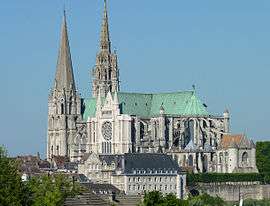Chartres
| Chartres | ||
|---|---|---|
|
Chartres Cathedral in late-May 2010 | ||
| ||
 Chartres | ||
|
Location within Centre-Val de Loire region  Chartres | ||
| Coordinates: 48°27′22″N 1°29′02″E / 48.456°N 1.484°ECoordinates: 48°27′22″N 1°29′02″E / 48.456°N 1.484°E | ||
| Country | France | |
| Region | Centre-Val de Loire | |
| Department | Eure-et-Loir | |
| Arrondissement | Chartres | |
| Intercommunality | Chartres Métropole | |
| Government | ||
| • Mayor (2008-2020) | Jean-Pierre Gorges | |
| Area1 | 16.85 km2 (6.51 sq mi) | |
| Population (2011)2 | 39,273 | |
| • Density | 2,300/km2 (6,000/sq mi) | |
| Time zone | CET (UTC+1) | |
| • Summer (DST) | CEST (UTC+2) | |
| INSEE/Postal code | 28085 / 28000 | |
| Elevation |
121–161 m (397–528 ft) (avg. 142 m or 466 ft) | |
|
1 French Land Register data, which excludes lakes, ponds, glaciers > 1 km² (0.386 sq mi or 247 acres) and river estuaries. 2 Population without double counting: residents of multiple communes (e.g., students and military personnel) only counted once. | ||
Chartres (French pronunciation: [ʃaʁtʁ]) is a commune and capital of the Eure-et-Loir department in France. It is located 96 km (60 mi) southwest of Paris. This city is well known for its cathedral.
History
Chartres was in Gaul one of the principal towns of the Carnutes, a Celtic tribe. In the Gallo-Roman period, it was called Autricum, name derived from the river Autura (Eure), and afterwards civitas Carnutum, "city of the Carnutes", from which Chartres got its name. The city was burned by the Normans in 858, and unsuccessfully besieged by them in 911.
During the Middle Ages, it was the most important town of the Beauce. It gave its name to a county which was held by the counts of Blois, and the counts of Champagne, and afterwards by the House of Châtillon, a member of which sold it to the Crown in 1286.
In 1417, during the Hundred Years' War, Chartres fell into the hands of the English, from whom it was recovered in 1432.
In 1528, it was raised to the rank of a duchy by Francis I.
In 1568, during the Wars of Religion, Chartres was unsuccessfully besieged by the Huguenot leader, the Prince of Condé. It was finally taken by the royal troops of Henry IV on 19 April 1591. On Sunday, 27 February 1594, the cathedral of Chartres was the site of the coronation of Henry IV after he converted to the Catholic faith, the only king of France whose coronation ceremony was not performed in Reims.
In 1674, Louis XIV raised Chartres from a duchy to a duchy peerage in favor of his nephew, Duke Philippe II of Orléans. The title of Duke of Chartres was hereditary in the House of Orléans, and given to the eldest son of the Duke of Orléans.
In the 1870-1871 Franco-Prussian War, Chartres was seized by the Germans on 2 October 1870, and continued during the rest of the war to be an important centre of operations.
In World War II, the city suffered heavy damage by bombing and during the battle of Chartres in August 1944, but its cathedral was spared by an American Army officer who challenged the order to destroy it.[1] On 16 August 1944, Colonel Welborn Barton Griffith, Jr. questioned the necessity of destroying the cathedral and volunteered to go behind enemy lines to find out whether the Germans were using it as an observation post. With his driver, Griffith proceeded to the cathedral and, after searching it all the way up its bell tower, confirmed to Headquarters that it was empty of Germans. The order to destroy the cathedral was withdrawn. Colonel Griffith was killed in action later on that day in the town of Lèves, 3.5 kilometres (2.2 miles) north of Chartres.[1][2] For his heroic action both at Chartres and Lèves, Colonel Griffith received, posthumously, several decorations awarded by the President of the United States and the U.S. Military, and also from the French government[3]
Following deep reconnaissance missions in the region by the 3rd Cavalry Group and units of the 1139 Engineer Combat Group, and after heavy fighting in and around the city, Chartres was liberated, on 18 August 1944, by the U.S. 5th Infantry and 7th Armored Divisions belonging to the XX Corps of the U.S. Third Army commanded by General George S. Patton.[4]
Climate
| Climate data for Chartres (1981–2010 averages) | |||||||||||||
|---|---|---|---|---|---|---|---|---|---|---|---|---|---|
| Month | Jan | Feb | Mar | Apr | May | Jun | Jul | Aug | Sep | Oct | Nov | Dec | Year |
| Record high °C (°F) | 16.1 (61) |
18.5 (65.3) |
23.7 (74.7) |
28.2 (82.8) |
31.4 (88.5) |
36.3 (97.3) |
40.1 (104.2) |
39.6 (103.3) |
33.7 (92.7) |
29.4 (84.9) |
20.9 (69.6) |
17.0 (62.6) |
40.1 (104.2) |
| Average high °C (°F) | 6.4 (43.5) |
7.6 (45.7) |
11.5 (52.7) |
14.7 (58.5) |
18.4 (65.1) |
21.8 (71.2) |
24.6 (76.3) |
24.6 (76.3) |
20.9 (69.6) |
15.9 (60.6) |
10.2 (50.4) |
6.7 (44.1) |
15.3 (59.5) |
| Average low °C (°F) | 1.2 (34.2) |
1.0 (33.8) |
3.2 (37.8) |
4.8 (40.6) |
8.3 (46.9) |
11.2 (52.2) |
13.2 (55.8) |
13.1 (55.6) |
10.4 (50.7) |
7.8 (46) |
4.1 (39.4) |
1.8 (35.2) |
6.7 (44.1) |
| Record low °C (°F) | −18.4 (−1.1) |
−15.0 (5) |
−11.0 (12.2) |
−4.9 (23.2) |
−1.0 (30.2) |
1.4 (34.5) |
0.9 (33.6) |
3.0 (37.4) |
0.5 (32.9) |
−5.4 (22.3) |
−11.3 (11.7) |
−14.2 (6.4) |
−18.4 (−1.1) |
| Average precipitation mm (inches) | 49.2 (1.937) |
40.2 (1.583) |
44.4 (1.748) |
45.0 (1.772) |
54.7 (2.154) |
48.2 (1.898) |
56.5 (2.224) |
43.0 (1.693) |
46.9 (1.846) |
62.3 (2.453) |
52.2 (2.055) |
56.3 (2.217) |
598.9 (23.579) |
| Average precipitation days | 10.4 | 9.1 | 9.7 | 9.0 | 9.9 | 8.0 | 7.7 | 6.5 | 7.7 | 10.0 | 10.4 | 10.8 | 109.1 |
| Average relative humidity (%) | 89 | 85 | 80 | 75 | 77 | 76 | 74 | 75 | 79 | 86 | 89 | 90 | 81.3 |
| Mean monthly sunshine hours | 65.7 | 83.7 | 135.8 | 176.1 | 202.9 | 222.6 | 224.5 | 219.6 | 177.8 | 119.2 | 71.9 | 58.2 | 1,758 |
| Source #1: Météo France[5][6] | |||||||||||||
| Source #2: Infoclimat.fr (humidity, 1961–1990)[7] | |||||||||||||
Population
| Historical population | ||
|---|---|---|
| Year | Pop. | ±% |
| 1793 | 15,000 | — |
| 1800 | 13,794 | −8.0% |
| 1806 | 13,809 | +0.1% |
| 1821 | 13,714 | −0.7% |
| 1831 | 14,439 | +5.3% |
| 1836 | 14,750 | +2.2% |
| 1841 | 16,383 | +11.1% |
| 1846 | 17,353 | +5.9% |
| 1851 | 18,234 | +5.1% |
| 1856 | 18,925 | +3.8% |
| 1861 | 19,531 | +3.2% |
| 1866 | 19,442 | −0.5% |
| 1872 | 19,580 | +0.7% |
| 1876 | 20,468 | +4.5% |
| 1881 | 21,080 | +3.0% |
| 1886 | 21,903 | +3.9% |
| 1891 | 23,108 | +5.5% |
| 1896 | 23,182 | +0.3% |
| 1901 | 23,431 | +1.1% |
| 1906 | 23,219 | −0.9% |
| 1911 | 24,103 | +3.8% |
| 1921 | 23,349 | −3.1% |
| 1926 | 24,630 | +5.5% |
| 1931 | 25,357 | +3.0% |
| 1936 | 27,077 | +6.8% |
| 1946 | 26,422 | −2.4% |
| 1954 | 28,740 | +8.8% |
| 1962 | 31,495 | +9.6% |
| 1968 | 34,469 | +9.4% |
| 1975 | 38,928 | +12.9% |
| 1982 | 37,119 | −4.6% |
| 1990 | 39,595 | +6.7% |
| 1999 | 40,361 | +1.9% |
| 2008 | 39,159 | −3.0% |
| 2011 | 39,273 | +0.3% |
Geography
Chartres is built on a hill on the left bank of the Eure River. Its renowned medieval cathedral is at the top of the hill, and its two spires are visible from miles away across the flat surrounding lands. To the southeast stretches the fertile plain of Beauce, the "granary of France", of which the town is the commercial centre.
Main sights
Cathedrals and churches
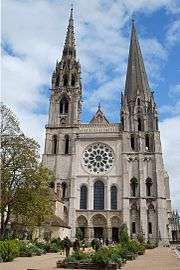


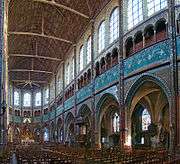
Chartres is best known for its cathedral, the Cathédrale Notre-Dame de Chartres, which is considered one of the finest and best preserved Gothic cathedrals in France and in Europe. Its historical and cultural importance has been recognized by its inclusion on the UNESCO list of World Heritage Sites. It was built on the site of the former Chartres cathedral of Romanesque architecture, which was destroyed by fire in 1194. (That former cathedral had been built on the ruins of an ancient Celtic temple later replaced by a Roman temple.) Begun in 1205, the construction of Notre-Dame de Chartres was completed 66 years later.
The stained glass windows of the cathedral were financed by guilds of merchants and craftsmen, and by wealthy noblemen, whose names appear at the bottom. It is not known how the famous and unique blue, bleu de Chartres, of the glass was created, and it has been impossible to replicate it. The French author Michel Pastoureau, says that it could also be called bleu de Saint-Denis.[8]
The Église Saint-Pierre de Chartres, was the church of the Benedictine Abbaye Saint-Père-en-Vallée, founded in the 7th century by queen Balthild. At time of its construction, the abbey was outside the walls of the city. It contains fine stained glass, twelve representations of the apostles in enamel, created about 1547 by Léonard Limosin.
Other noteworthy churches of Chartres are Saint-Aignan (13th, 16th and 17th centuries), and Saint-Martin-au-Val (12th century), inside the Saint-Brice hospital.
Museums
- Musée des Beaux-Arts, Fine arts museum, housed in the former episcopal palace adjacent to the cathedral.
- Musée le grenier de l'histoire, history museum specializing in military uniforms and accoutrements, in Lèves.
- Le Centre international du vitrail, a workshop-museum and cultural center devoted to stained glass art, located 50 metres (160 feet) from the cathedral.
- Muséum des sciences naturelles et de la préhistoire, Natural Science and Prehistory Museum
- Conservatoire du machinisme et des pratiques agricoles, an agricultural museum
Other sights
The Eure River, which at this point divides into three branches, is crossed by several bridges, some of them ancient, and is fringed in places by remains of the old fortifications, of which the Porte Guillaume (14th century), a gateway flanked by towers, was the most complete specimen, until destroyed by the retreating German army in the night of 15 to 16 August 1944. The steep, narrow streets of the old town contrast with the wide, shady boulevards which encircle it and separate it from the suburbs. The Cbs St Jean, a pleasant park, lies to the north-west, and squares and open spaces are numerous.
The Hôtel de Ville (City Hall), a building of the 17th century, houses a museum and a library. The Maison Canoniale dating back to the 13th century, and several medieval and Renaissance houses, are of interest.
There is a statue of General Marceau (1769-1796), a native of Charres and a general during the French Revolution.
- La Maison Picassiette, a house decorated inside and out with mosaics of shards of broken china and pottery.
Economy
Chartres is one of the most important market towns in the region of Beauce (known as "the granary of France").
The game pies and other delicacies of Chartres are well known, and the industries also include flour-milling, brewing, distilling, iron-founding, leather manufacture, perfumes, dyeing, and the manufacture of electronic equipment, car accessories, stained glass, billiard requisites and hosiery.
Since 1976 fashion and perfumes company Puig has a production plant in this commune.[9]
Transport
The Gare de Chartres railway station offers frequent services to Paris, and a few daily connections to Le Mans, Nogent-le-Rotrou and Courtalain. The A11 motorway connects Chartres with Paris and Le Mans.
Sport
Chartres is home to two semi-professional association football clubs; FC Chartres, who play in the French sixth division, and HB Chartres, who play in the seventh tier.
Chartres has a table tennis club which is playing in the Pro A (French First division) and in the European Champions League. The club won the ETTU Cup on the season 2010 – 2011 and it finished at the second position in the French First division.
Chartres has the second most important squash club in France.
There is also a handball club and it is playing in the French second division.
In November 2012, Chartres organized the European Short Course Swimming Championships.
Diocese
The town is the seat of a diocese (bishopric), a prefecture, and a cour d'assises. It has a Tribunal de grande instance, a Tribunal d'instance, a Chamber of commerce and a branch of the Banque de France.
Public and religious schooling from kindergarten through high school and vocational schools is given in mixed (boys and girls) establishments. The two main high schools are the Lycée Jehan de Beauce and the Lycée Marceau, named after two important personages of the history of Chartres: Jehan de Beauce was a 16th-century architect who rebuilt the northern steeple of the cathedral after it had been destroyed by lightning in July 1506, and Marceau, a native of city, who was a general during the French Revolution of 1789.
Pilgrimages
Chartres has been a site of Catholic pilgrimages since the Middle Ages. The poet Charles Péguy (1873–1914) revived the pilgrimage route between Paris and Chartres before World War I. After the war, some students carried on the pilgrimage in his memory. Since 1982, the association Notre-Dame de Chrétienté,[10] with offices in Versailles, organizes the annual 100 km (62 mi) pilgrimage on foot from Notre-Dame de Paris to Notre-Dame de Chartres. About 15,000 pilgrims, from France and countries outside France, participate every year.
Bishops
Notable bishops of Chartres:
- Fulbert of Chartres (1007–1029)
- St. Ivo of Chartres (1090–1115)
- John of Salisbury (1176–1180)
- Erard de la Marck (1472–1538)
Personalities
Chartres was the birthplace of:
- Hélène Boucher (1908-1934), a French pilot
- Jacques Pierre Brissot (1754–1793), a leading member of the Girondist movement (French Revolution)
- Julien Cetout footballer
- Arlette Chabot (1951-), French journalist
- Fulcher of Chartres (born around 1059 in or near Chartres), chronicler of the First Crusade
- Philippe de Dangeau (1638–1720), officer and member of the Académie française
- Philippe Desportes (1546–1606), poet
- Antoine François Desrues (1744–1777), poisoner
- Loïc Duval (born 12 June 1982), professional racingdriver; currently A1 Team France, Formula Nippon and Super GT
- Julien Escudé (born 1979), professional footballer for Sevilla FC and the France national football team
- Nicolas Escudé (born 1976), professional tennis player
- André Félibien (1619–1695), architect and historiographer
- Achille Guénée (1809–1880), lawyer and entomologist
- Pierre-Jules Hetzel (1814–1886), editor and publisher
- Eric Lada footballer
- François Séverin Marceau-Desgraviers (1769–1796), general
- Pierre Nicole (1625–1695), Jansenist theologian
- Jérôme Pétion de Villeneuve (1756–1794), writer and politician
- Allison Pineau handball player
- André Plassart (1889–1978), hellenist, epigrapher and archaeologist
- Mathurin Régnier (1573–1613), satirist
- Jacqueline de Romilly (1913-2010), philologist, classical scholar and fiction writer
International relations
Twin towns – Sister cities
Chartres is twinned with:
 Ravenna in Italy (since 1957)
Ravenna in Italy (since 1957) Speyer in Germany (since 1959)
Speyer in Germany (since 1959) Chichester in the United Kingdom (since 1959)[11]
Chichester in the United Kingdom (since 1959)[11] Bethlehem in Palestinian Authority (since 1995)[12][13]
Bethlehem in Palestinian Authority (since 1995)[12][13] Évora in Portugal (since 2003)
Évora in Portugal (since 2003) Cusco in Peru (since 1989)[14]
Cusco in Peru (since 1989)[14] Sakurai, Nara in Japan (since 1989)
Sakurai, Nara in Japan (since 1989)
Gallery
 Chartres railway station
Chartres railway station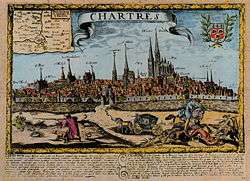 17th-century engraving of Chartres "skyline"
17th-century engraving of Chartres "skyline" The cathedral of Chartres
The cathedral of Chartres The Apostles and Saint sculptures of Chartres
The Apostles and Saint sculptures of Chartres The Old Town – Eure River
The Old Town – Eure River Half-timbered house in the Old Town
Half-timbered house in the Old Town Hill of Saint François
Hill of Saint François View south from the cathedral
View south from the cathedral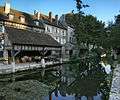 On the banks of the Eure River
On the banks of the Eure River
See also
References
- INSEE
 This article incorporates text from a publication now in the public domain: Chisholm, Hugh, ed. (1911). "Chartres". Encyclopædia Britannica. 5 (11th ed.). Cambridge University Press. p. 954.
This article incorporates text from a publication now in the public domain: Chisholm, Hugh, ed. (1911). "Chartres". Encyclopædia Britannica. 5 (11th ed.). Cambridge University Press. p. 954.- Chartres and the Chartres Cathedral – Visitor Guide
- La Maison Picassiette in Chartres
- 1 2 MilitaryTimes.com. "MilitaryTimes Hall of Valor". Welborn Barton Griffith, Jr. Military Times, a Gannett Company. Retrieved 10 May 2011. Note: The Distinguished Service Cross was awarded posthumously for saving the cathedral.
- ↑ Jay Nordlinger (2011). "A Colonel at Chartres". The Corner. NationalReview.com. Retrieved 11 May 2011.
- ↑ On 21 October 1944, for his heroic action, Colonel Welborn B. Griffith, Jr. was awarded, posthumously, the Distinguished Service Cross:Hall of Valor: Welborn Barton Griffith, Jr. He was also awarded the Silver Star, the Purple Heart, the Legion of Merit, the French Croix de Guerre and the Légion d'Honneur: Eugene G. Schulz, The Ghost in General Patton's Third Army, USA, 2012. ISBN 978-1477141441
- ↑ Winieska, Françoise, August 1944, The Liberation of Rambouillet, France, SHARY, 1999, pp. 19–23, ISBN 2-9514047-0-0
- ↑ "Données climatiques de la station de Chartres" (in French). Meteo France. Retrieved December 30, 2015.
- ↑ "Climat Centre-Val de Loire" (in French). Meteo France. Retrieved December 30, 2015.
- ↑ "Normes et records 1961-1990: Chartres - Champhol (28) - altitude 155m" (in French). Infoclimat. Retrieved December 30, 2015.
- ↑ Pastoureau, Michel, Bleu: histoire d'une couleur', Seuil, Paris, 2000. ISBN 978-2757840016
- ↑ "To be multinational in Spain costs a lot, because the domestic market is too small". La Vanguardia. Retrieved May 9, 2012.
- ↑ Association Notre-Dame de Chrétienté
- ↑ "British towns twinned with French towns [via WaybackMachine.com]". Archant Community Media Ltd. Archived from the original on 5 July 2013. Retrieved 2013-07-20.
- ↑ "Twinning with Palestine". 1998–2008 The Britain – Palestine Twinning Network. Archived from the original on 28 June 2012. Retrieved 29 November 2008.
- ↑ "::Bethlehem Municipality::". bethlehem-city.org. Archived from the original on 24 July 2010. Retrieved 10 October 2009.
- ↑ "Ciudades Hermanas (Sister Cities)" (in Spanish). Municipalidad del Cusco. Archived from the original on 3 August 2009. Retrieved 23 September 2009.
External links
| Wikimedia Commons has media related to Chartres. |
| Wikivoyage has a travel guide for Chartres. |
- Tourist office website
- City council website (in French)
- Chartres' archeology service website (in French)
- Website about archaeological excavations (in French)
- Visiting Chartres (English)
- Photo of the abbey church of St.Pierre
- Music recorded in Chartres Cathedral in the resonant space of the labyrinth
- Chartres World Heritage Site in panographies – 360 degree interactive imaging
